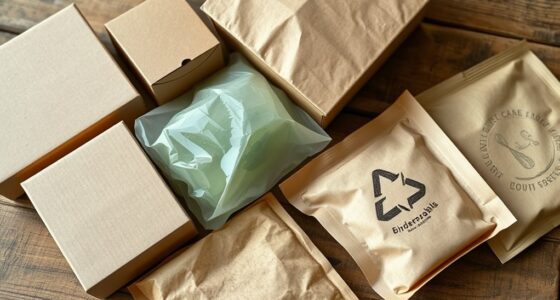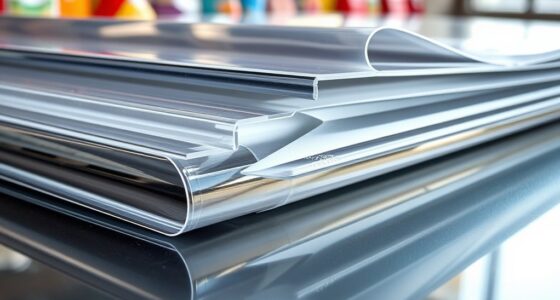Kraft paper is a durable material made primarily from wood pulp. You'll notice it has a distinct brown color and coarse texture. This strength comes from the kraft process, which reduces lignin content, enhancing fiber bonding. It's used widely in packaging, arts and crafts, and even food products because it can handle heavy loads. You can find various types, including natural and bleached options, each suited for different applications. Plus, it's biodegradable and recyclable, making it an eco-friendly choice. Want to know how to use it effectively or discover its growing market trends? There's more to explore!
Key Takeaways
- Kraft paper is a strong, durable paper made from chemical pulp via the kraft process, known for its low lignin content.
- It typically appears in a natural brown color and is highly absorbent, making it suitable for various applications.
- Common types include Natural Kraft Paper, used for heavy-duty packaging, and Bleached Kraft Paper, ideal for food packaging.
- Kraft paper is biodegradable and recyclable, supporting environmental sustainability and promoting renewable resource use.
- It is widely utilized in packaging, crafting, food storage, and construction, owing to its strength and eco-friendly characteristics.
Definition and Origin
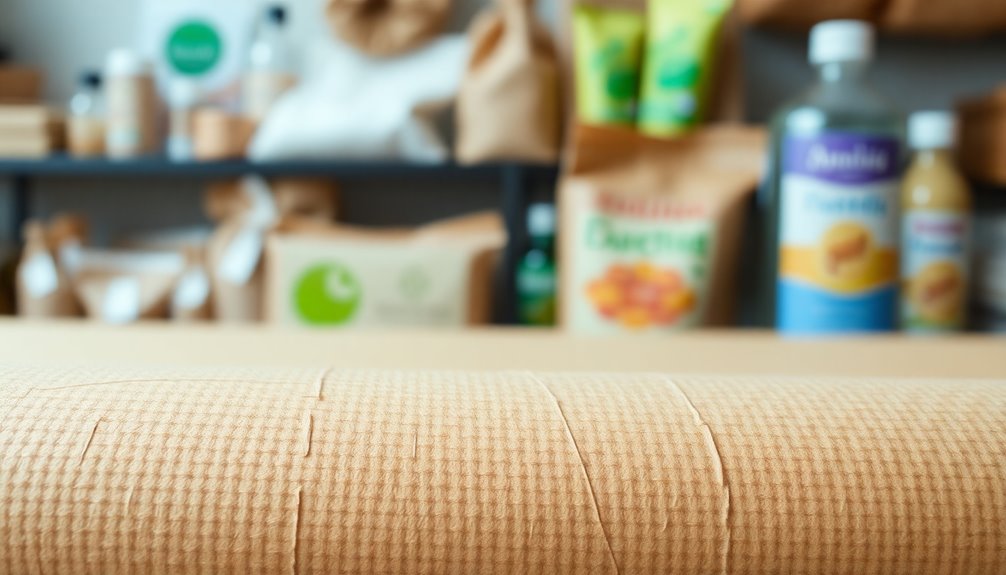
Kraft paper is often recognized for its remarkable strength and durability, making it a popular choice in various applications. The term "kraft" comes from the German word for "strength," reflecting its superior tensile strength compared to other paper types.
At its core, kraft paper is defined as a strong, durable paper produced from chemical pulp through the kraft process. This process, developed in the 1880s by Carl F. Dahl, treats wood with sodium sulfide and sodium hydroxide, resulting in a product with a low lignin content. This low lignin content enhances hydrogen bonding among fibers, which contributes to kraft paper's impressive strength and tear resistance.
Kraft paper typically showcases a natural brown color, coarse texture, and high porosity, distinguishing it from more refined paper types often used for artistic purposes.
The versatility of the kraft process allows for the use of various fiber sources, including non-wood options, further expanding its applications. Whether you're using it for packaging, crafts, or other purposes, understanding the definition and origin of kraft paper helps you appreciate its unique qualities and benefits.
Manufacturing Process

To understand the manufacturing process of kraft paper, you first need to look at wood chip preparation.
Companies cook these wood chips in a chemical solution to extract the cellulose needed for strong pulp.
This critical step sets the stage for various pulping and processing techniques that enhance the paper's durability.
Wood Chip Preparation
Preparing wood chips for kraft paper involves a meticulous process that greatly impacts the final product's quality. You start by sourcing primarily from softwood species, as their long fibers are essential for enhancing the strength and durability of the kraft paper.
Once you have the wood, the first step is to debark and chip it into smaller pieces. This size reduction is important for efficient cooking during the pulping process.
Next, the wood chips undergo a cooking process in a solution of sodium sulfide and sodium hydroxide. This chemical treatment is critical for separating lignin from cellulose, allowing you to produce high-quality pulp. The quality and size of the wood chips markedly influence the strength and properties of the final product, so it's imperative to verify they meet the necessary standards.
After the cooking process, you'll screen and wash the chips to remove any residues. This guarantees that only the best cellulose pulp is used in the manufacturing process, setting the stage for the creation of robust kraft paper.
Each step in wood chip preparation is fundamental to achieving the desired characteristics in the final product.
Pulping and Processing Techniques
When it comes to producing kraft paper, the pulping and processing techniques play a pivotal role in determining the quality of the final product. The kraft process involves cooking wood chips in a mix of sodium sulfide and sodium hydroxide, effectively separating lignin from cellulose. This results in wood pulp that boasts superior tensile strength, making it stronger than papers produced through other pulping processes like acidic sulfite or mechanical methods.
In kraft paper production, softwood fibers are primarily used due to their long fiber length, which contributes to the paper's overall strength and durability. The versatility of the kraft process allows for various fiber sources, including non-wood options, promoting sustainable practices in manufacturing.
Once the pulping is complete, the kraft paper is formed into sheets using paper machines. These machines enable additional treatments, such as microcrepping or coatings, to enhance properties like porosity and moisture resistance.
Types of Kraft Paper

When you explore the types of kraft paper, you'll come across Natural Kraft and Bleached Kraft.
Natural Kraft is unbleached and brown, offering great strength for various applications.
On the other hand, Bleached Kraft has a white finish, making it perfect for food packaging, though it's slightly less durable.
Natural Kraft Paper
Natural Kraft Paper (NK) stands out as the strongest type of kraft paper, thanks to its unbleached, brown composition. This paper is specifically designed for heavy-duty applications, making it ideal for multiwall bags that require exceptional tensile strength. With a basis weight ranging from 18 to 200 lbs, NK is commonly found in weights between 25 and 80 lbs, ensuring it meets various packaging needs.
You'll appreciate that natural kraft paper isn't only durable but also biodegradable and recyclable, promoting sustainability in your packaging materials. This makes it a preferred choice for industries like construction, where sturdy packaging is essential, and food packaging, where safety is paramount.
It's also widely used for consumer goods, as its robust properties and natural aesthetic appeal to eco-conscious shoppers. When you choose natural kraft paper, you're opting for a material that can withstand significant stress, making it reliable for heavy items.
Its unbleached nature helps it maintain strength while supporting environmentally friendly practices. Overall, NK is a versatile solution for those seeking effective and sustainable packaging options.
Bleached Kraft Paper
Bleached kraft paper offers a distinct contrast to its natural counterpart, showcasing a white appearance achieved through a bleaching process that removes lignin from wood pulp. This type of kraft paper is ideal for applications where a clean aesthetic is essential, making it a popular choice for food packaging, especially for items like flour and sugar bags.
While bleached kraft paper typically has about 15% less tensile strength compared to natural kraft paper due to the bleaching process, it provides improved printing quality, which is significant for labels and packaging. The grammage of bleached kraft paper usually ranges from 40 to 90 g/m², allowing you to select the right weight and strength for your packaging needs.
As you consider the environmental impact of your choices, it's worth noting that alternative bleaching methods, such as chlorine dioxide and oxygen bleaching, are being adopted to reduce harmful byproducts compared to traditional chlorine bleaching.
This shift not only enhances sustainability but also helps meet the growing demand for eco-friendly materials in various industries. Ultimately, bleached kraft paper combines functionality with a polished look, making it a versatile option for modern packaging solutions.
Key Characteristics
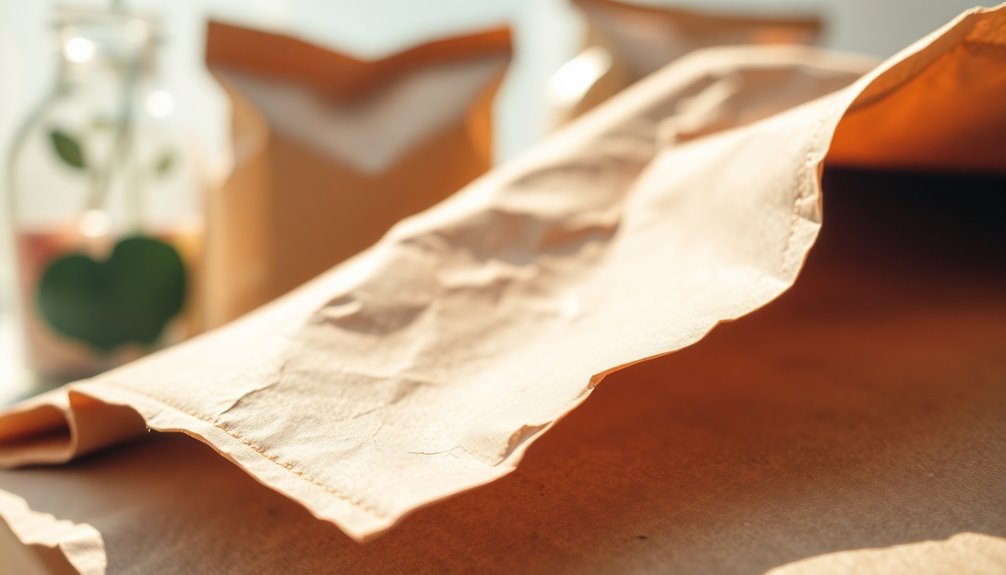
Kraft paper boasts several key characteristics that make it stand out in the world of packaging and crafting. One of its most notable features is its high tensile strength, which comes from the low lignin content and the kraft process used in its production. This durability makes Kraft paper a reliable packaging material for various applications.
Typically, it has an unbleached, coarse texture and a natural brown color, giving it a rustic look that many find appealing.
Additionally, Kraft paper is highly absorbent, allowing it to effectively manage moisture when treated with specific coatings like polyethylene, enhancing its moisture resistance. You'll find different types of Kraft paper, including absorbent kraft and recycled kraft paper, tailored for specific uses such as bags and food packaging.
Another significant aspect of Kraft paper is its biodegradability. This characteristic supports environmental sustainability, making it a preferred choice over plastic alternatives.
Applications of Kraft Paper
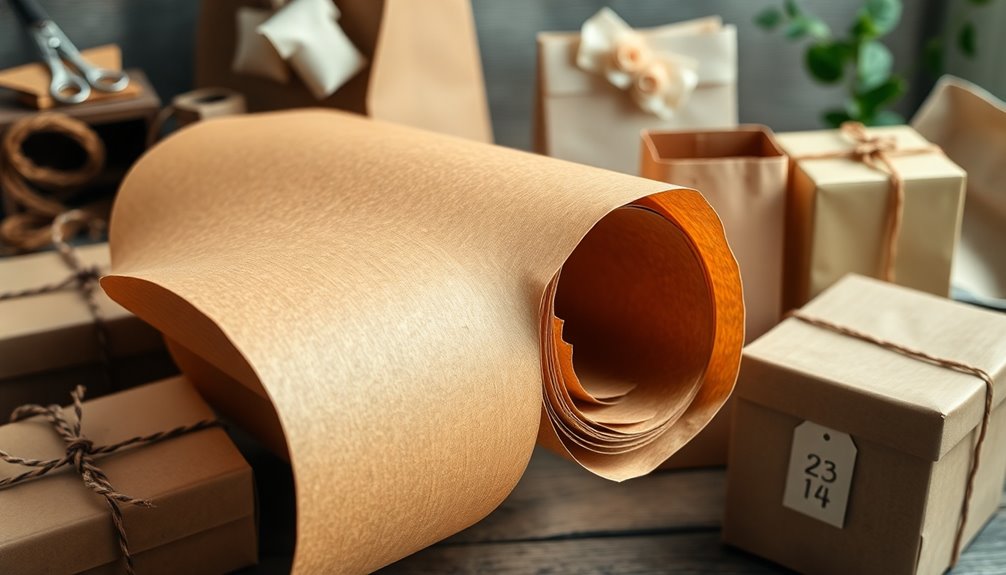
From packaging to crafting, the applications of kraft paper are diverse and impactful. Its high tensile strength and durability make it a popular choice in various packaging applications, including paper sacks for cement, food, and chemicals. You'll find that kraft paper serves as an eco-friendly alternative for flour bags, offering a plastic-free option that meets safety standards in food packaging.
Here's a quick overview of its applications:
| Application | Description |
|---|---|
| Shipping | Ideal for protective wrapping, ensuring products arrive safely. |
| Crafting Industry | Perfect for arts and crafts, including gift wrapping and DIY projects. |
| E-commerce Sector | Favored for its durability, ensuring secure delivery and protection of items. |
| Industrial Use | Versatile enough for lightweight to heavy-duty packaging needs. |
With its numerous uses, kraft paper has become a staple in both commercial and personal applications. Whether you're shipping products or getting creative, you can trust kraft paper to deliver quality and sustainability.
Environmental Impact

The environmental impact of kraft paper is considerable, making it a preferred choice for eco-conscious consumers and businesses alike. Unlike plastic, kraft paper is made from renewable wood pulp, promoting sustainable forestry practices that help reduce reliance on non-renewable resources. This shift not only contributes to a healthier planet but also aligns with the growing demand for eco-friendly solutions in the packaging industry.
When you choose kraft paper, you're opting for a product that boasts a lower overall environmental impact. Its manufacturing process generates less pollution compared to plastic production, ensuring a cleaner environment.
Plus, kraft paper is both biodegradable and recyclable, playing an essential role in the circular economy by minimizing landfill waste.
Innovations in kraft paper production, such as incorporating non-wood fibers and eco-friendly coatings, further enhance its sustainability and recyclability. With a markedly lower carbon footprint than plastic alternatives, kraft paper stands out as an excellent choice for those looking to reduce their environmental impact.
Benefits of Kraft Paper
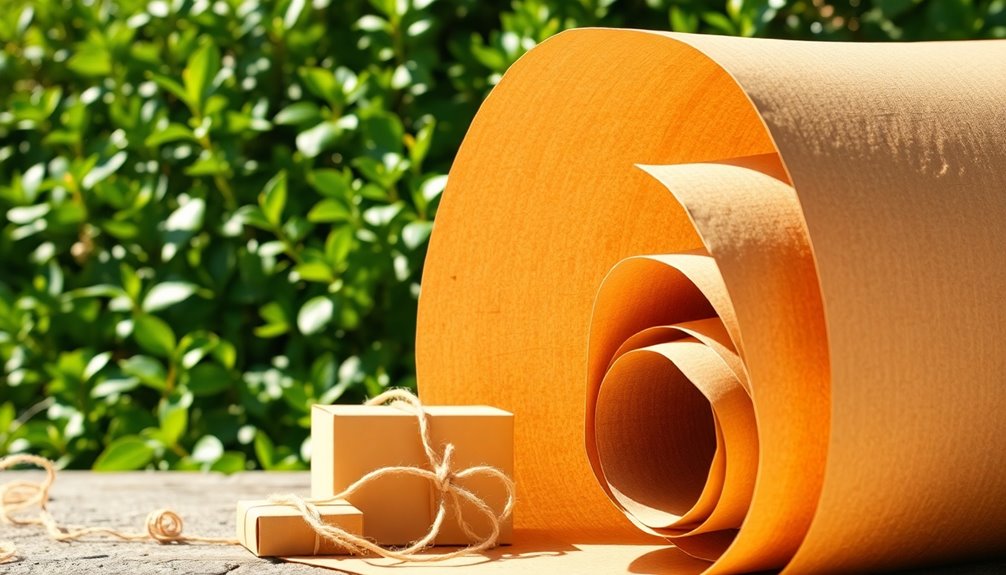
Choosing kraft paper not only supports a sustainable future but also brings a range of benefits that make it a top choice for packaging and other applications. Kraft paper is known for its high tensile strength, making it ideal for heavy-duty packaging needs. Its durability and resistance to tearing guarantee that your products remain safe during transport.
Additionally, kraft paper is eco-friendly, being biodegradable and recyclable, which reduces environmental impact compared to plastic alternatives. The natural aesthetic of kraft paper adds a rustic charm, appealing to consumers who value eco-conscious packaging. You'll appreciate that it's customizable, allowing you to enhance your branding while maintaining cost-effectiveness.
With its lightweight properties, kraft paper helps reduce shipping costs, making it practical for a variety of packaging applications. Here's a quick overview of the benefits:
| Benefit | Description | Impact |
|---|---|---|
| Tensile Strength | High resistance for heavy-duty needs | Guarantees product safety |
| Biodegradable | Breaks down naturally in the environment | Reduces waste |
| Customizable | Various finishes available | Enhances branding |
| Lightweight | Lowers shipping costs | Cost-effective solutions |
| Natural Aesthetic | Rustic charm appeals to eco-conscious buyers | Attracts consumer interest |
Tips for Using Kraft Paper
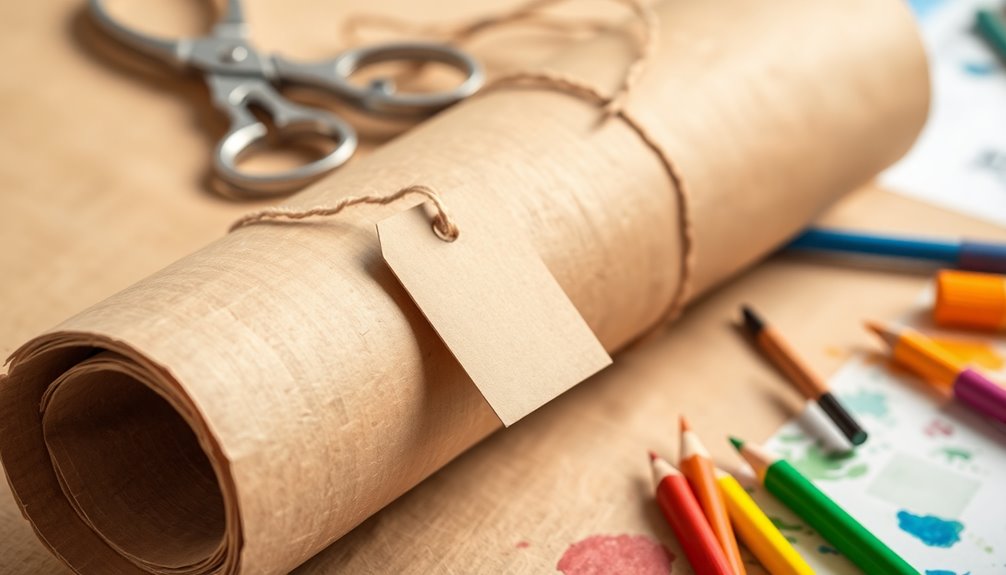
When you use kraft paper for packaging, layering multiple sheets can greatly boost protection for fragile items during shipping and handling. Here are some tips to make the most of your kraft paper:
- Choose the Right Adhesives: Opt for eco-friendly adhesives or tapes that complement the natural aesthetic of kraft paper. This keeps your packaging looking professional and appealing.
- Get Creative with Customization: Kraft paper is perfect for personalizing your gifts. Use stamps, paints, or markers to create customized designs that add a unique touch to your projects.
- Store Properly: Make certain you keep your kraft paper in a cool, dry place. This prevents moisture absorption, which can compromise its strength and durability over time.
When printing on kraft paper, remember to use high-quality inks. They'll provide good contrast against the natural brown surface, enhancing visibility and appeal.
Frequently Asked Questions
What Is the Difference Between Kraft Paper and Regular Paper?
When you compare kraft paper to regular paper, you'll notice a few key differences.
Kraft paper's got a rougher texture and a brown color, while regular paper is smoother and brighter. It's also stronger, making it ideal for heavy-duty tasks.
Plus, kraft paper is more eco-friendly, as it recycles better and uses fewer harmful processes.
Regular paper works well for lightweight printing and writing, but kraft paper stands out for durability and sustainability.
What Is Kraft Paper Made Out Of?
Kraft paper's made primarily from wood pulp sourced from softwood trees, known for their long fibers that enhance strength.
You'll find that the production involves a process where wood chips undergo treatment with sodium sulfide and sodium hydroxide. This method separates lignin from cellulose, creating a strong pulp.
The resulting paper retains a natural brown color and coarse texture, making it both durable and versatile for various applications in your projects.
Is Kraft Paper the Same as Brown Paper?
No, kraft paper isn't the same as brown paper.
While both might look similar, kraft paper's made using a specific process that gives it more strength and durability.
Brown paper can come from various methods and often lacks the tensile strength of kraft paper.
So, if you're looking for something sturdy for packaging or crafting, you'll want to choose kraft paper over regular brown paper.
It really makes a difference in quality!
Is Kraft Paper Like Cardboard?
Kraft paper and cardboard aren't quite the same, though they share similarities.
You'll find kraft paper is thinner and more flexible, making it ideal for wrapping and crafts.
Cardboard, on the other hand, is thicker and sturdier, often used for boxes and packaging.
While both materials come from wood pulp and are recyclable, their textures and uses differ considerably, so it's important to choose the right one for your specific needs.
Conclusion
To sum up, kraft paper is a versatile, eco-friendly material that's perfect for various applications, from packaging to crafts. Its unique manufacturing process and strong characteristics make it a go-to choice for many. By choosing kraft paper, you not only benefit from its durability but also contribute to a more sustainable environment. So next time you're looking for reliable and environmentally conscious options, consider kraft paper to meet your needs!



